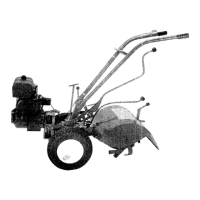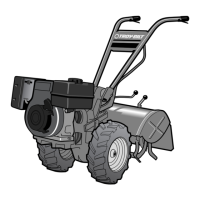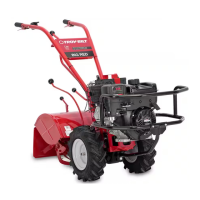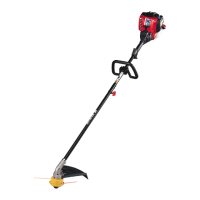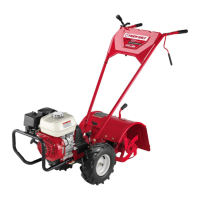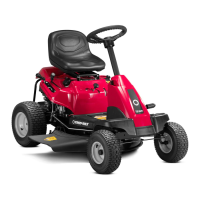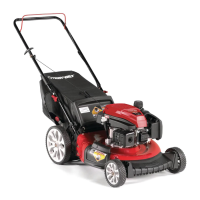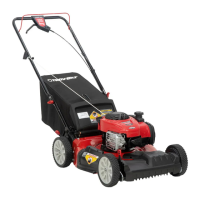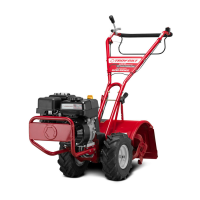You
will
see
that
there is a fuse
on
the
battery
recharging
line
coming
from
the
engine, as
shown in Photo 7/58. Remove
the
fuse and look
at it carefully. (Push
the
two
halves
of
the
fuse
holder
together
and
turn
the
top
half
counter-
clockwise
to
separate
the
two
halves.) If
the
fuse is okay, then
there
is a fair chance that it is
either
your
diode
not
recharging
your
battery
(causing
your
battery
to
be run
down),
or
that
the
fault is with the
electric
start
motor
on
your
engine. If
you
feel it is the
electric
start
motor
on
your
engine, it
would
be best
for
you
to have an
authorized
Tecumseh service dealer
look
at
your
engine
to
solve the problem.
If
your
electric start
motor
turns
over
but
does
not
start the engine,
it
may be
that
you
should
be
looking
toward
other
engine
functions
for
the
answer
to
your
problem. Check
for
problems
with the fuel,
ignition
or
carburetor.
ENGINE STOPSWITCH (6
HPTECUMSEH)
If
you
cannot
start
your
engine
for
any
appar-
ent reason,
one
thing
to
do
is
to
check
the
ac-
tion
of
the
engine
shutoff
switch
(shortout
clip)
underneath
the
speed
control
assembly bracket
by
the
carburetor. As
shown
in
Photo
4/14 in
Section 4 (on engines),
the
shutoff
switch
is a
berlt tab
underneath
the
bracket
to
which
is
attached a
wire
leading
into
the
engine's
mag-
neto.
If
the
spring
clip
is bent so
that
it
touches
the
bracket at all times,
it
will
be
doing
the
same
thing
as
stopping
the
engine; and therefore,
preventing
you
from
starting
the
engine.
A
~imple
way
to
check
this
is
to
disconnect
the
terminal at the
clip
and
put
some electrical tape
on the wire's end
to
make sure
it
touches
no
me-
tal at all-see
Photo
7/628.
And
then,
try
to
start
your
engine. If
your
engine
starts
right
up,
you
know
that
the tab
was
grounding
the
engine
out
and preventing
it
from
starting. All
you
have
to
do
is bend
the
tab
out
a
little
way
and then
make sure
that
the
remote
control
lever
com-
pletes the
connection
and
stops
the
engine
as
it
should.
See
Photo
7/63.
A
short
somewhere else in
this
wire
would
be
more serious and
would
have
to
be taken care
of
by a service dealer. This, however, is a
very rare occurrence.
IGNITION
SYSTEM
If
your
engine
won't
start, the
most
common
causes are ignition, electrical
(for
battery start
engines), fuel
or
carburetion
problems. Many
of
these causes can be
corrected
easily and
quick-
ly, once they are determined.
If
your
carburetor
is adjusted
correctly,
and
you have enough compression
to
run
the
en-
gine, and
your
fuel is fresh, clean and
without
any water in it, then
not
being able
to
start
might
well be the fault
of
your
ignition
system.
The first
thing
to investigate in
checking
igni-
tion problems is
your
spark plug and its wire.
Make sure that
the
connection
to
the wire is se-
cure and there are no breaks
or
bare
spots
on
the
wire.
Then, remove
the
spark
plug
and
look
at it. If
the plug is dirty, encrusted
with
deposits and
corroded, you'd best replace it.
Look
at
the
gap
to
be sure that
it
is
within
tolerance. See
the
specifications table
for
your
engine
(at
the
end
of
Section
9)
for
the spark
plug
gap. If there is
wet oil on the plug,
look
for
the
source
of
the oil problem
(which
is
most
likely
your
real
problem).
Is
your
oil
too
full, are
the
rings
worn
on
the
piston, is
the
crankcase
breather
clogged?
If
you
have a
good
or
a
new
spark
plug
(re-
moved
from
the
engine), attach
the
lead
wire
to
it and lay
the
plug
down
on
any
metal
part
of
the engine. Then,
pull
the
starter
rope
with
a
firm
pull and observe
the
gap in the spark
plug
while
you
do
it. If
you
see a
strong,
bright
spark,
your
ignition
system seems
to
be in
working
or-
der, so
look
in
other
directions
for
your
failure
to start the engine. If
you
don't
get
a spark
or
get a very weak
spark
with
a
good
or
new
plug
touching
metal,
you
can
expect
a
problem
with
the
ignition
system itself
or
with
the
engine
shutoff
switch
and wire.
119
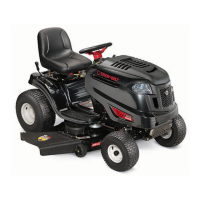
